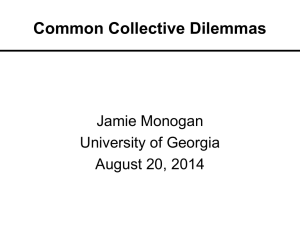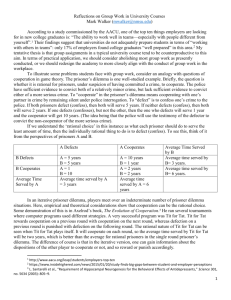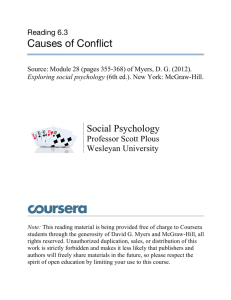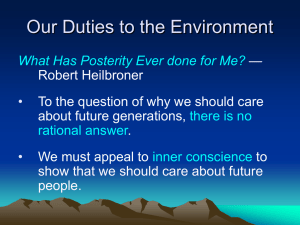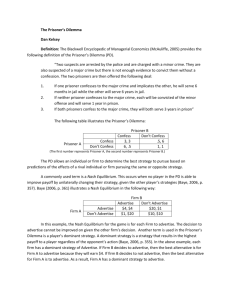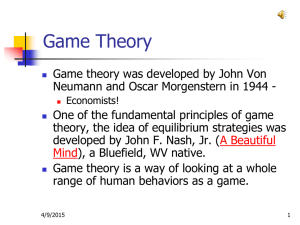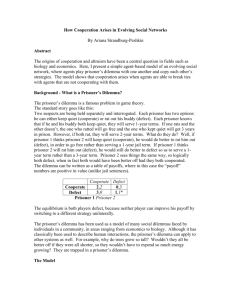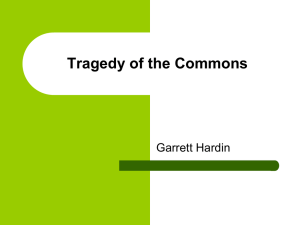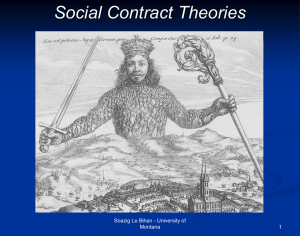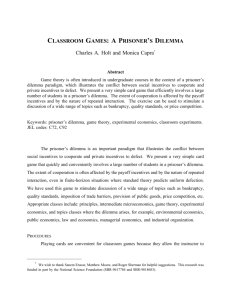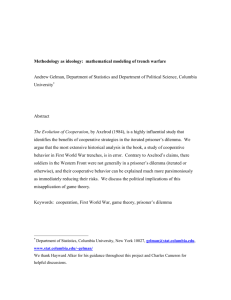The Tragedy of the Commons
advertisement
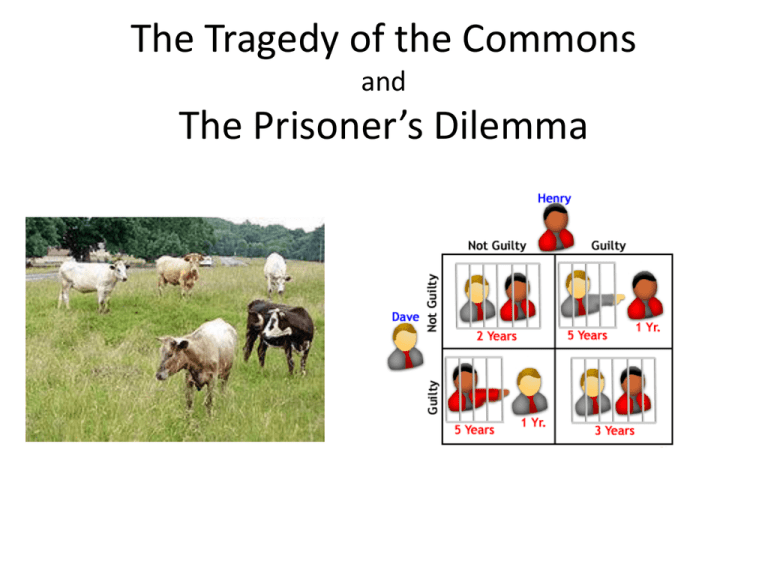
The Tragedy of the Commons and The Prisoner’s Dilemma Thomas Malthus • 1798, writes critique of Condorcet et al • Food supplies increase additively (linear) • Population increases geometrically (nonlinear) Thomas Malthus • Malthus argued that two types of checks hold population within resource • catastrophic checks: hunger, disease and war • preventive checks: abortion, birth control, prostitution, postponement of marriage and celibacy • God created this situation deliberately to ensure our moral development Herbert Spencer "A Theory of Population" (1852) • Malthus proves that welfare to the poor is like feeding rats: you only get more rats • Social Darwinism: humanitarian impulses should be resisted so that the social struggle for existence can remove the unfit. The Tragedy of the Commons Garrett Hardin, 1968 • The class of "No technical solution problems" has members. My thesis is that the "population problem," as conventionally conceived, is a member of this class. • It is fair to say that most people who anguish over the population problem are trying to find a way to avoid the evils of overpopulation without relinquishing any of the privileges they now enjoy. They think that farming the seas or developing new strains of wheat will solve the problem-technologically. I try to show here that the solution they seek cannot be found. The Tragedy of the Commons Garrett Hardin, 1968 • Herders sharing a common parcel of land, on which they are each entitled to let their cows graze. • It is in each herder's individual interest to put as many cows as he acquires onto the land. • A herders might be aware of overgrazing dangers, but to limit cows would just further exacerbate the decrease to income from the overgrazing. • Modern examples: overfishing of the world's oceans, timber extraction, etc. Even advertising. The Tragedy of the Commons Garrett Hardin, 1968 • Hardin laments this interpretation of The Universal Declaration of Human Rights (United Nations): The Universal Declaration of Human Rights describes the family as the natural and fundamental unit of society. [Article 16[10]] It follows that any choice and decision with regard to the size of the family must irrevocably rest with the family itself, and cannot be made by anyone else. The Tragedy of the Commons Garrett Hardin, 1968 • Hardin essentially repeats the arguments of Hobbs: • Education is not a solution, humans need higher authority for coercion • The authority can be a government dictatorship that regulates human reproduction (communist model) or capitalist market that privatizes ownership of all resources (Spencer’s solution) Game Theory Approach to the Psychology of the Commons: The Prisoner’s Dilemma Hofstadter’s example: You have diamonds, your dealer has money. You both agree to leave bags at designated places in forest: 1. You leave a full bag, but his bag is empty. You get ripped off. 2. You leave an empty bag, he leaves a full one. You have doubled your wealth. 3. You leave an empty bag, and he leaves an empty bag: no worse off than you are already. Therefore, economic “rationalism” demands that you leave an empty bag. Since the dealer is in the same situation, you both receive nothing. The Prisoner’s Dilemma You have both been accused of a crime: 1. You both stay mum, you each get 2 years in jail 2. You rat out your partner: you are free, he gets 5 3. You both rat each other out, you each get 4 years in jail “Rational self-interest” gives a sub-optimum result! Origins of Prisoner’s Dilemma RAND in 1950s: US and USSR each want to eliminate nukes • If you both reduce nukes (“mutual cooperation”) you both get safer world • If US keeps nukes (“defect”) and USSR gets rid of them (“cooperates”), US has security, USSR insecure. • If you both keep nukes (“mutual defection”), you both get insecure world The Prisoner’s Dilemma applies to many situations in which lack of trust destroys our ability to cooperate • Human population: why should I have a small family to prevent over-population, if others do not? • Renewable resources: why should I limit my (grazing, hunting, fishing, pollution) if others do not? • International security: why should I reduce nukes if others do not? • Advertisements: why should I make small billboards if others make larger ones? • Sleazy crap on TV: why should I offer viewers intelligent programming if others get more views from sleazy crap? The Prisoner’s Dilemma is our Race to the Bottom The Prisoner’s Dilemma: canonical version Two players have the choice of cooperating or defecting. Temptation to defect is the highest payoff (5) Reward for mutual cooperation is second highest payoff (3) Punishment for mutual defection is third highest (1) Sucker’s payoff (cooperating during defect) is lowest (0) T>R>P>S and (T+S)/2 < R are required conditions More generally, this is A “Nash Equilibrium” The Iterated Prisoner’s Dilemma: Robert Axelrod 1979 • Researchers asked to submit program that makes the Cooperation/Defect decision • Programs can keep track of each other, and change in response to prior moves • Included random, always cooperate, and always defect • Every program interacts with every other program 200 times, including a clone of itself • Scores are cumulative: it doesn’t matter how many times you “lost”—only the sum of the scores matter The Iterated Prisoner’s Dilemma winner: Rapoport’s tit for tat The first time meeting a program, cooperate The next time, repeat what it did last time. If T4T meets itself, they cooperate If T4T meets defect-only, it only gets fooled once If T4T meets random chooser (eg JOSS), it will retaliate on the next move (often when JOSS cooperates) The Iterated Prisoner’s Dilemma winner: Rapoport’s Tit for Tat Axelrod attributes the success to 3 levels of analysis • Direct effect of a choice: defection earns more • Indirect effect: you may get punished in retaliation • “tertiary effect”: unending mutual recrimination—hence the crucial importance of forgiveness Spatial prisoner’s dilemma (Martin Nowak) Runs like cellular automaton Spatial structure allows “islands” of cooperation to rise in sea of defectors Iterated Prisoner’s Dilemma Solves the problem of Evolutionarily Stable Strategies Acorn Woodpecker: Why don’t “freeloaders” rise in genetic frequency? Other Evolutionarily Stable Strategies The Side-Blotched Lizard (Uta stansburiana) is polymorphic with three morphs that each pursues a different mating strategy 1) The Orange throat is very aggressive and operates over a large territory attempting to mate with numerous females within this larger area 2) The unaggressive Yellow Throat (called “sneakers”) mimic the markings/behavior of female lizards and sneakily slip into the Orange Throat's territory to mate with the females there (thereby overtaking the population), and 3) The Blue Throat who mates with and carefully guards ONE female - making it impossible for the sneakers to succeed and therefore overtakes their place in a population…

